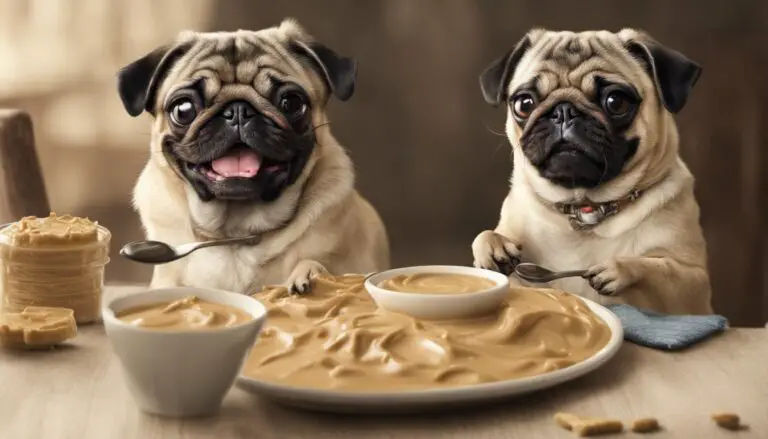Can Pugs Eat Green Peppers? A Nutritional Guide for Dog Owners
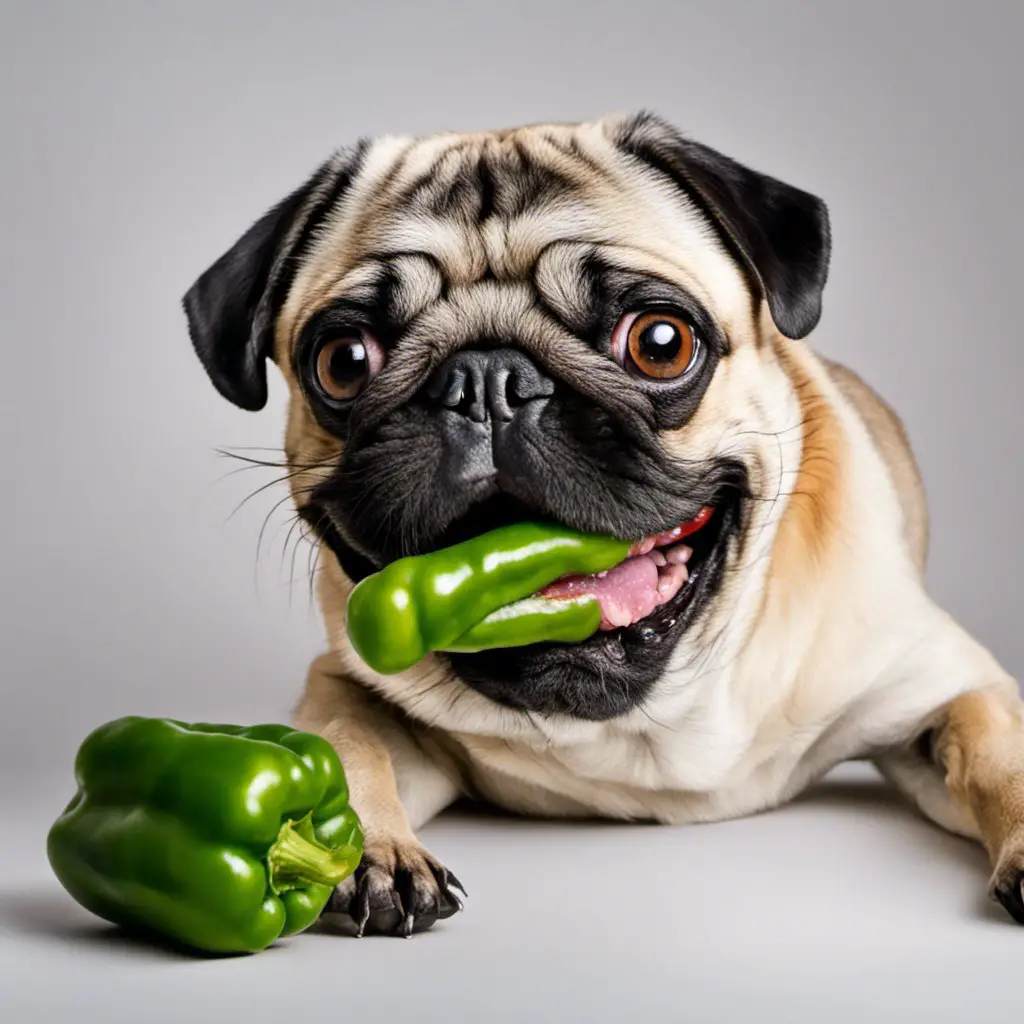
As a pug owner, knowing which foods are safe for your furry friend to consume is important. One question that often comes up is, “Can Pugs Eat Green Peppers”. Green peppers, also known as bell peppers, are a popular vegetable known for their crisp texture and slightly bitter flavor. The good news is that pugs can safely enjoy this tasty veggie!
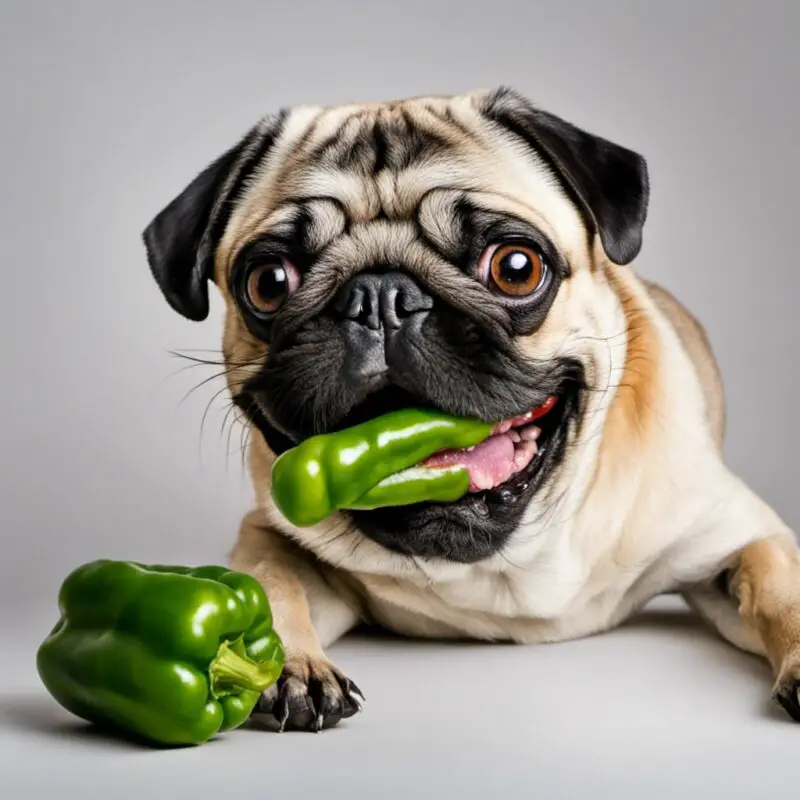
Bell peppers are not only safe for pugs, but they also offer various health benefits. These vegetables are low in calories and high in vitamins A and C, which are essential for maintaining your pug’s immune system and overall health. Bell peppers of all colors, including green, red, and yellow, are equally safe and nutritious for your pug to eat.
Introducing green peppers into your pug’s diet can be a fun and healthy way to add variety to their meals. However, moderation is key when it comes to feeding your pug any human food. Always consult with your vet before making any significant changes to your pug’s diet, and ensure that the peppers are thoroughly washed and free of any seeds or stems before serving them to your pet.
Contents
Table of Contents
Pugs and Their Diet
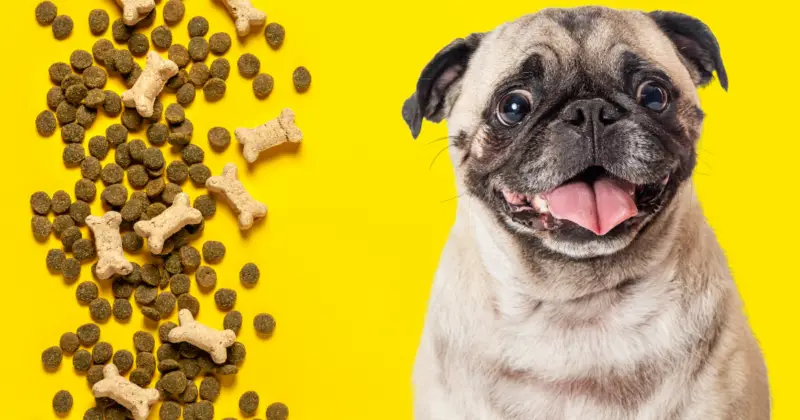
Pugs are small, friendly, and adorable dogs known for their distinctive facial features and loving nature. Their diet plays a critical role in their overall health and well-being. As omnivores, pugs can eat a variety of foods, including vegetables, fruits, and meat.
Get The Free Food Eating Guide That Keeps My Pug Happy and Playful Even at 13 Years Old
100% Beginner Friendly & Lists Real Foods Your Pug Can Actually Eat!

Vegetables offer essential nutrients that contribute to a healthy canine diet. Many veggies, such as green peppers, provide a good source of vitamins, minerals, and antioxidants. Green peppers can be added to your pug’s diet as an occasional treat, and they are known to be safe for pugs to eat.
Other vegetables that are beneficial for pugs include carrots, sweet potatoes, and beets. However, ensuring the vegetable is clean and appropriately prepared before feeding it to your pug is crucial.
Aside from vegetables, fruits can also be an excellent addition to a pug’s diet. They can enjoy blackberries, which are low in calories and sugar and high in vitamins, minerals, and antioxidants. Watermelon, apples, and bananas can also be fed to pugs, as long as it is in moderation and without seeds or rind.
Meat is another essential component of a pug’s diet. Pugs require substantial protein in their diets to support their muscles, bones, and overall health. Chicken, turkey, and lean beef can be included in their meals. However, it is necessary to avoid feeding them processed or seasoned meats, as these might contain harmful additives and high levels of salt.
To maintain a balanced diet, offering your pug a mix of vegetables, fruits, and meat is crucial. However, always consult a veterinarian or pet nutrition expert when making changes to your pug’s diet. This ensures that they get the appropriate nutrients and calories without overfeeding them.
Can Pugs Eat Green Peppers?

Yes, pugs can safely eat green peppers as an occasional treat. Green peppers, also known as bell peppers, are a healthy and nutritious snack for pugs. These vegetables are low in calories and high in vitamins and minerals, making them an excellent addition to your pug’s diet.
Green peppers are rich in antioxidants, such as vitamin C, which can help support your pug’s immune system. In addition to vitamin C, green peppers also contain other vitamins like vitamins A and B6, which can contribute to your dog’s overall health and well-being. The fiber content in green peppers can also aid in digestion and weight management for your pug.
When offering green peppers to your pug, it’s essential to prepare them properly. Make sure to remove the seeds and the inner white part of the pepper, as these can be difficult for your pug to digest. Chop the green pepper into small, bite-sized pieces that are easy for your pug to eat and prevent choking. For the best flavor, you can serve the green pepper, either raw or slightly steamed. Avoid using any seasonings, as these can be harmful to your dog.
While green peppers are a safe and beneficial treat for pugs, moderation is crucial. Offering too many green peppers at once can cause gastrointestinal upset in your dog. As a rule of thumb, green peppers should not make up more than 10% of your pug’s daily food intake. Also, be mindful of any potential allergies or sensitivities your pug may have.
In summary, when given in moderation, green peppers can be a nutritious and enjoyable treat for your pug. Properly prepared and served, these vegetables can provide valuable vitamins and minerals to support your pug’s overall health. Monitor your pug’s reaction to green peppers and adjust their diet to ensure their well-being.
Health Benefits of Green Peppers for Pugs
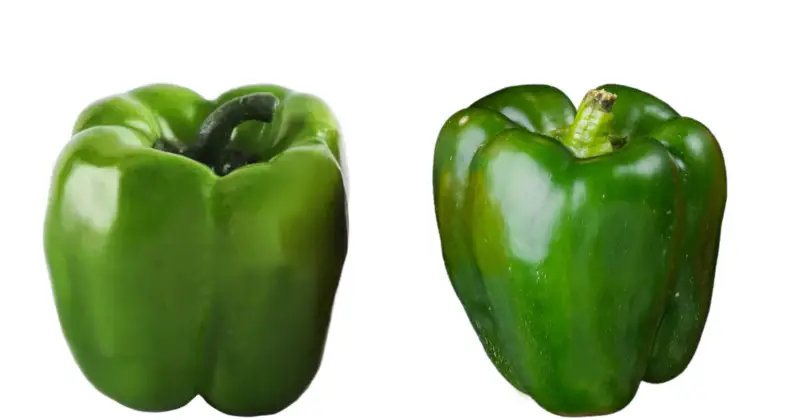
Green peppers offer a variety of health benefits for pugs and make for a nutritious treat when offered in moderation. They are low-calorie vegetables packed with essential vitamins and minerals to support your pug’s overall well-being.
One notable component of green peppers is their high vitamin C content. This crucial vitamin is essential in maintaining a healthy immune system, helping keep your pug strong and resilient against infections. Green peppers are also a fantastic source of vitamin A, which contributes to optimal vision and a well-functioning immune system.
In addition to these vitamins, green peppers are abundant in beta-carotene, a powerful antioxidant that can help neutralize harmful free radicals in your pug’s body. This antioxidant supports overall health and well-being by reducing oxidative stress, which can contribute to inflammation and various health issues.
Green peppers also provide a good amount of dietary fiber, which can help keep your pug’s digestive system functioning smoothly. Dietary fiber plays a key role in maintaining digestive health and preventing issues such as constipation and diarrhea.
Furthermore, green peppers contain potassium, a crucial mineral vital in maintaining proper fluid balance, muscle function, and nerve communication. Ensuring your pug gets adequate potassium is essential for overall health and well-being.
In conclusion, incorporating green peppers into your pug’s diet in moderation can provide numerous health benefits. These colorful, low-calorie vegetables are rich in essential vitamins, minerals, fiber, and antioxidants to support your pug’s overall health and well-being.
Possible Issues and Concerns

Although green peppers are safe for pugs to consume in moderation, you should be aware of some possible issues and concerns when introducing this food into your pug’s diet. Overfeeding green peppers to your dog may lead to indigestion, diarrhea, or vomiting in some cases, especially if they are not accustomed to consuming the vegetable.
It is important to note that certain vegetables can be toxic to dogs in general. Some toxic vegetables to avoid feeding your pug include onions, garlic, chives, and nightshade family members like tomatoes and potatoes. Similarly, feeding your pug leeks can be harmful, as they contain thiosulfate, which can cause red blood cell damage in dogs.
When feeding green peppers, make sure that they are properly prepared. Remove any seeds and cut the peppers into small pieces to help your pug chew and digest them more easily. This can help minimize the potential risks associated with choking, especially in smaller dog breeds like pugs.
In summary, feeding green peppers to your pug can be a healthy addition to their diet in moderation. Keep an eye on any potential adverse reactions and ensure that you are not introducing toxic vegetables or large, whole pieces that could pose a choking hazard.
How to Serve Green Peppers to Pugs
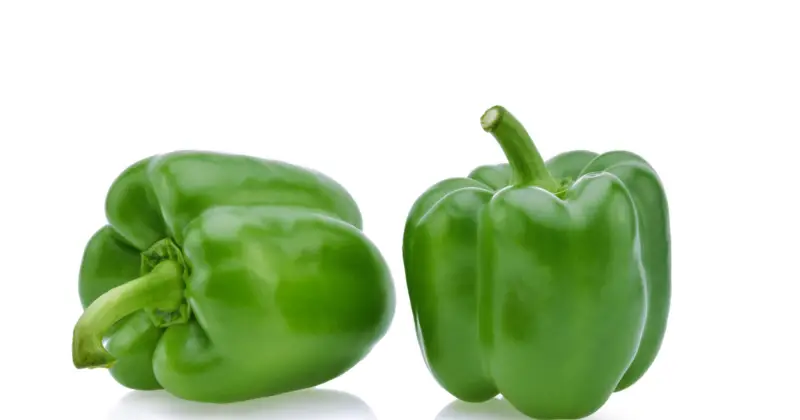
When served properly, Green and bell peppers can be a healthy and tasty treat for your pug. To ensure your pet enjoys the benefits of these nutritious vegetables without any risks, follow the guidelines below for serving green peppers to pugs.
First, washing the green pepper thoroughly is essential, as unclean vegetables may carry harmful bacteria. After that, remove the stem and seeds, which can pose a choking hazard for your pug source. Remember to cut the green pepper into small, manageable pieces that would be easy for your pug to chew and swallow. Depending on your pug’s preference, You can offer the green pepper raw or slightly cooked.
Steaming is an excellent option for cooking green peppers because it retains the essential nutrients while making the vegetable softer and easier for your pug to digest. Avoid seasoning the peppers with salt or other spices, as they can harm your pet. Keep the cooking process simple, focusing on maintaining the green pepper’s natural goodness.
While green peppers can be a delightful treat for pugs, make sure not to overfeed them with this vegetable. Moderation is key to ensuring your pug gets a balanced diet. Introduce green peppers in small amounts, gradually increasing the quantity as your pug becomes accustomed to the new food.
In summary, serving green peppers to pugs can benefit their diet if you follow the right steps. Always remember to clean and cut the peppers, remove the seeds and stems, and serve them raw or slightly cooked without any added salt or seasonings. This way, your pug can enjoy the health benefits of green peppers without any risks.
What Pugs Can and Can’t Eat? | Guide to Pug Diet and Food Habits
Peppers to Avoid
While it is safe for pugs to enjoy bell peppers, such as green peppers, there are certain types of peppers that should be avoided. Spicy peppers, like jalapeños and chili peppers, contain capsaicin, which can cause discomfort and digestive issues in dogs.
If consumed by your pug, Jalapeños and other spicy peppers can lead to symptoms such as diarrhea, vomiting, and excessive drooling. Capsaicin, the compound responsible for the heat in these peppers, can also cause more serious issues like gastrointestinal irritation, oral irritation, and difficulty breathing. Additionally, spicy peppers may contribute to dog inflammation, causing discomfort and exacerbating existing health conditions.
Aside from avoiding spicy peppers, it’s essential also to be mindful of how the peppers are prepared. Any additional ingredients like garlic, onions, salt, or oil can be harmful to dogs and should be eliminated when offering them bell peppers as a treat. For example, when feeding your pug green peppers, try steaming or boiling them without any additives to preserve their nutritional value while making them easier to digest.
In summary, while bell peppers, including green peppers, make for a healthy treat for pugs, it is crucial to avoid feeding them spicy peppers like jalapeños and chili peppers due to capsaicin’s potentially harmful effects. Additionally, take care to provide them with peppers that are devoid of toxic ingredients or additives.
Harmful Food for Pugs

When it comes to feeding pugs, it’s essential to be aware of foods that can be harmful to them. Many common human foods contain substances that can be toxic or poisonous to pugs, causing health issues or even life-threatening conditions. While some foods may be harmless to humans, they can cause severe problems for pugs.
One of the most common harmful ingredients for pugs is onion. Onions and other members of the allium family, like garlic, chives, and leeks, contain compounds that can be toxic to dogs.
These compounds can cause gastrointestinal irritation and possibly lead to red blood cell damage, which could result in anemia. Keeping onions, garlic, chives, and leeks out of your pug’s diet is important.
Another potentially toxic food for pugs is chocolate. Chocolate contains theobromine, a substance that is poisonous to dogs. According to DoggySaurus, chocolate is one of the most poisonous pug foods due to the toxic theobromine substance. Consuming chocolate can lead to vomiting, diarrhea, seizures, and in severe cases, heart failure. Always keep chocolate away from your pug’s reach.
In addition to avoiding harmful foods, monitoring the quality of the food you’re feeding your pug is crucial. As mentioned on Pet Creeks, moldy or stale food, even industrially prepared dry kibble, can be dangerous to pugs. Mycotoxins produced by moldy food can make pugs sick if ingested.
Lastly, be cautious with high-fat foods. Pugs are prone to weight gain and obesity, so avoiding feeding them such items is essential. Small Animal Advice explains that fatty foods can lead to gastrointestinal upset, vomiting, diarrhea, and even pancreatitis (inflammation of the pancreas). Maintain a balanced and healthy diet for your pug to prevent these issues.
Alternatives to Green Peppers
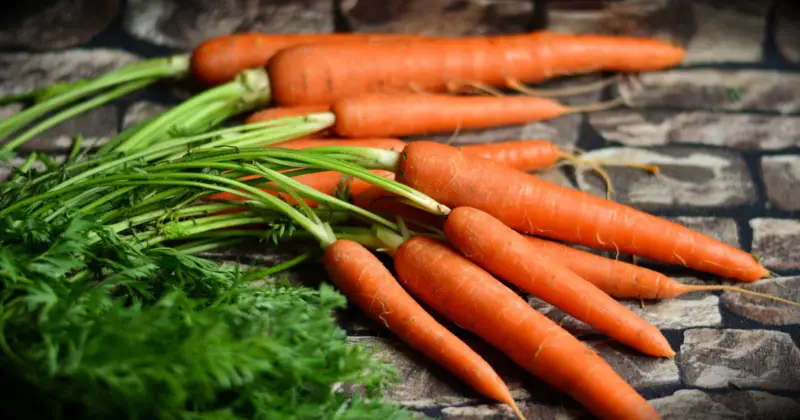
In addition to green peppers, there are several other vegetables and fruits that can be safely fed to your pug. These alternatives can provide different flavors and nutrients to your pet’s diet, which is beneficial for their overall health.
Carrots are a great option, as they are high in vitamins and minerals. They can be fed to your pug raw or cooked and can even help clean your pet’s teeth when given as a crunchy snack. Broccoli is another healthy choice, containing vitamins, minerals, and antioxidants that can help improve your pug’s immune system. However, it should be given in moderation, as too much can lead to digestive issues.
Sweet potatoes are a rich source of dietary fiber, vitamins, and minerals and can be served cooked as a tasty treat for your pug. Similarly, green beans are low in calories and high in fiber, making them a suitable snack for weight management. Both vegetables can be mixed into your pug’s regular food to add variety and a healthy boost.
Celery can be a refreshing option for pugs, as it is 95% water and is packed with various vitamins and minerals. This makes it particularly suitable for consumption during the summertime. Peas and cucumbers are also hydrating options for your pug, providing a mix of essential nutrients and low-calorie content.
Corn is another option for pugs, but it should only be given occasionally, as it is high in carbohydrates and can contribute to weight gain if fed too frequently. When feeding corn to your pug, ensure it is off the cob, as the cob can pose a choking hazard.
Lastly, spinach is a nutrient-dense leafy green that can be offered to your pug in small quantities. It is rich in vitamins, minerals, and antioxidants but should be given in moderation due to the presence of oxalates, which can potentially affect kidney function in large amounts.
In summary, numerous vegetable and fruit alternatives to green peppers can be safely incorporated into your pug’s diet. Always consult with your veterinarian before introducing new foods to your pet, and monitor for any signs of digestive issues or allergies.
Conclusion and Guidance from a Veterinarian

Consulting with a veterinarian is always the best approach when it comes to your pug’s dietary needs. Although green peppers are considered safe for dogs to consume, it is essential to consider factors like their individual health conditions and dietary requirements.
For pugs, green peppers can be a nutritious addition to their diet. They contain essential nutrients, such as vitamins A and C, fiber, and antioxidants. These components contribute to maintaining a healthy immune system as well as efficient digestion. However, it is crucial to remember that moderation is key. Feeding your pug excessive amounts of green peppers could potentially cause gastrointestinal issues.
Introducing green peppers into your pug’s diet should be done gradually. Start by giving small, bite-sized pieces to observe how your pug reacts. Keep an eye on them for any signs of discomfort or adverse reactions. If your pug handles the green peppers well, you can continue to include them in their meals as a healthy treat.
It is important to note that while sweet bell peppers, like green peppers, are safe for your pug to consume, spicy peppers such as jalapeños or Serranos should be avoided. These types of peppers can cause irritation and discomfort to your pug’s digestive system, leading to potential health issues.
In summary, when fed in moderation, green peppers can be a healthy addition to your pug’s diet. It is essential to consult with your veterinarian for guidance on the appropriate serving size and frequency based on your pug’s specific dietary needs. And always remember to monitor your pug for any adverse reactions when introducing new foods into their diet.
Frequently Asked Questions: Can Pugs Eat Green Peppers

Can pugs consume raw green peppers?
Yes, pugs can consume raw green peppers without any problem. Green peppers are a nutritious and low-calorie treat for your pug. However, make sure to remove the seeds and wash the green pepper thoroughly before feeding it to your pug.
Is it safe for pugs to eat green pepper seeds?
It is best to remove green pepper seeds before feeding them to your pug. While the seeds are not toxic, they can be hard for your pug to digest and may cause discomfort or gastrointestinal upset.
Can pugs eat cooked bell peppers?
Yes, pugs can eat cooked bell peppers, but make sure to avoid adding any seasonings, spices, or oils that might be harmful to your pug. Steamed or boiled bell peppers are the best options, as they retain their nutrition and are easy for your pug to digest.
How often should pugs be fed green peppers?
Green peppers are best served in moderation as an occasional treat. While they are nutritious, it is important not to overfeed your pug with green peppers, as they should not replace the dog’s regular diet. Try incorporating green peppers as a snack once or twice per week.
Are bell peppers toxic to pugs?
Bell peppers, including green peppers, are not toxic to pugs. They are safe for pugs to eat and even provide valuable nutrients for their overall health. Always remember to remove seeds and serve in moderation.
Why are some peppers not recommended for dogs?
While bell peppers are safe for dogs, some other types of peppers, like hot or chili peppers, are not recommended. These peppers contain capsaicin, which can cause irritation, discomfort, and even pain for your pug. It is best to stick to the mild and non-spicy varieties of peppers for your dog’s safety and well-being.




